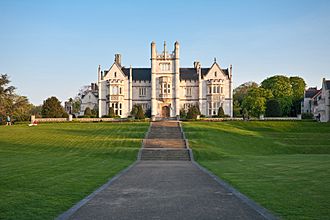Ingress Abbey facts for kids
Quick facts for kids Ingress Abbey |
|
|---|---|
|
Ingress Abbey
|
|

Ingress Abbey, front facade
|
|
| General information | |
| Status | Grade II listed |
| Type | Stately home |
| Architectural style | Jacobethan |
| Location | Greenhithe, Kent, England, UK |
| Coordinates | 51°27′08″N 0°17′20″E / 51.4521°N 0.2890°E |
| Construction started | 1833 |
Ingress Abbey is a grand old country house in Greenhithe, Kent, England. It was built in a style that mixes Neo-gothic and Jacobean designs. The current building was finished in 1833. It stands on the historic Ingress Estate, which has a long and interesting past.
Contents
Exploring the History of Ingress Estate
The Ingress Estate has been around for a very long time. It started as a manor, which is like a large country estate, in the small area of Greenhithe.
Early Days and the Priory
Back in 1363, King Edward III gave the Ingress manor to a religious group. This group was the only community of Dominican nuns in England, located in Dartford. Nuns are women who dedicate their lives to religious service. The King wanted to create a large religious community here.
The King's Confiscation and a Legend
During the 1500s, King Henry VIII made big changes in England. He closed down many monasteries and priories, taking their land and wealth. This event is known as the Dissolution of the Monasteries. The Ingress Estate was taken by the King.
A famous legend says that the head nun of Dartford, Jane Fane, put a curse on King Henry VIII and his male family members. The curse supposedly meant that no male heir would ever inherit the Ingress Estate.
King Henry VIII used the site as a country retreat. Later, in 1548, he gave the priory and manor of Dartford to Anne of Cleves, one of his wives.
Changes After Henry VIII
After Henry VIII died, some nuns tried to restart their community at Dartford. But in 1559, Queen Elizabeth I took over. She made everyone swear loyalty to her as the head of the church. The nuns refused and had to leave. The estate then went to Edward Darbyshire and John Bere.
New Owners and Big Plans
Over the centuries, the Ingress Estate changed hands many times. In 1748, it was sold to William, Viscount Duncannon, an important Irish nobleman. He improved the estate a lot. Some say he even hired the famous landscape designer Capability Brown to work on the gardens.
Later, the estate was owned by John Calcraft, a Member of Parliament (MP). An MP is a person elected to represent a group of people in the country's government.
One notable owner was William Havelock, a shipbuilder. His son, Sir Henry Havelock, who became a famous army officer, spent his early childhood at Ingress Estate.
Around 1820, the original house on the estate was torn down. This was because there were plans to build a huge dockyard in the area. However, these plans were later changed, and the dockyard was built elsewhere. The current Ingress Abbey was then built in 1833.
Discovering the Follies of Ingress Estate
The Ingress Estate is home to several interesting structures called "follies." In this context, a folly is a building or structure built mainly for decoration, often designed to look like an ancient ruin or a whimsical feature in a garden.
- The Cave of the Seven Heads: This cave is located near the main gate of the estate. It's now close to a modern bus road that goes through a tunnel.
- The Georgian Garden Bridge: This old bridge, made of flint and brick, dates back to the late 1700s or early 1800s. It's on the eastern side of the estate.
- The Georgian Wall Tunnel: This tunnel is carved into the chalk cliffs overlooking the estate. Its entrance is currently blocked for safety.
- The Grange and Adjacent Tunnel: This is a large, decorative archway that looks like a gatehouse. It has storage rooms and a winding tunnel carved out of the chalk.
- The Grotto: This is a group of small, flint-lined caves arranged in a semi-circle. They were once near the Abbey's driveway.
- The Lovers Arch: This is a flint-lined alcove, a bit like a small sheltered nook, where a bench is now placed.
- The Monkswell: This features a short tunnel leading to a round, vaulted chamber with a well. Some people have reported strange happenings here.
- The Prioress Tomb: This structure is located near the path leading to The Grange.
Ingress Abbey in Books and on Screen
Ingress Abbey is thought to have inspired "Carfax Abbey," the fictional English home of Count Dracula in Bram Stoker's famous novel, Dracula.
The Abbey has also been used as a filming location for various TV shows and movies, including:
- "The Kidnapped Prime Minister," an episode of the ITV drama Agatha Christie's Poirot.
- "He Who Dares: Downing Street Siege," a feature film.

